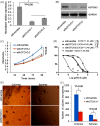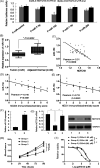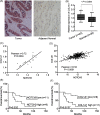NOTCH3 Overexpression and Posttranscriptional Regulation by miR-150 Were Associated With EGFR-TKI Resistance in Lung Adenocarcinoma
- PMID: 30732676
- PMCID: PMC7848279
- DOI: 10.3727/096504018X15372657298381
NOTCH3 Overexpression and Posttranscriptional Regulation by miR-150 Were Associated With EGFR-TKI Resistance in Lung Adenocarcinoma
Abstract
Acquired resistance remains a key challenge in epidermal growth factor receptor (EGFR)-tyrosine kinase inhibitors (TKIs) therapy in lung adenocarcinoma (LUAD). Recent studies have shown that Notch signaling is associated with drug resistance. However, its role and possible mechanisms in EGFR-TKI resistance are not yet clear. In our study, we found that among four members of NOTCH1-4, only NOTCH3 was upregulated in LUAD tissues and TKI-resistant cell line (HCC827GR6). Knockdown of NOTCH3 by siRNA significantly inhibited proliferative ability, and decreased colony and sphere formation in HCC827GR6 cells. Then miR-150 was identified as a posttranscriptional regulator of NOTCH3. Its expression was downregulated in LUAD tissues and negatively correlated with NOTCH3 mRNA. The cell proliferation and IC50 of gefitinib were decreased in HCC827GR6 cells transfected with miR-150 mimic, but was reversed when cotransfected with NOTCH3 overexpressed vector. Moreover, we also enrolled 20 patients with advanced LUAD who have taken TKIs as first-line therapy in this study. We found that collagen 1A1 (COL1A1) expression was increased significantly in LUAD tissues both at mRNA and protein levels, and positively correlated with NOTCH3 expression verified in our data and TCGA data. Univariate survival analysis showed that patients with high protein expression of NOTCH3 or COL1A1 were associated with shorter overall survival (OS). Taken together, these results suggest that miR-150/NOTCH3/COL1A1 axis contributed to EGFR-TKI resistance in LUAD, which provide a potential therapeutic target for LUAD treatment.
Conflict of interest statement
The authors declare no conflicts of interest.
Figures




References
-
- Siegel RL, Miller KD, Jemal A. Cancer Statistics, 2017. CA Cancer J Clin. 2017;67:7–30. - PubMed
-
- Lee DH. Treatments for EGFR-mutant non-small cell lung cancer (NSCLC): The road to a success, paved with failures. Pharmacol Ther. 2017;174:1–21. - PubMed
-
- Yi Y, Zeng S, Wang Z, Wu M, Ma Y, Ye X, Zhang B, Liu H. Cancer-associated fibroblasts promote epithelial-mesenchymal transition and EGFR-TKI resistance of non-small cell lung cancers via HGF/IGF-1/ANXA2 signaling. Biochim Biophys Acta 2018;1864:793–803. - PubMed
-
- Nakagawa T, Takeuchi S, Yamada T, Ebi H, Sano T, Nanjo S, Ishikawa D, Sato M, Hasegawa Y, Sekido Y, Yano S. EGFR-TKI resistance due to BIM polymorphism can be circumvented in combination with HDAC inhibition. Cancer Res. 2013;73:2428–34. - PubMed
MeSH terms
Substances
LinkOut - more resources
Full Text Sources
Medical
Research Materials
Miscellaneous
